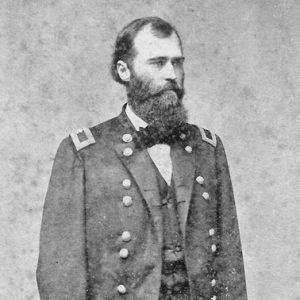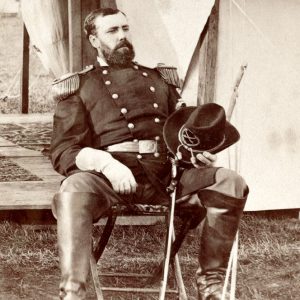calsfoundation@cals.org
Des Arc Bayou Expedition
aka: Searcy Expedition
aka: West Point Expedition
|
Location: |
|
|
Campaign: |
None |
|
Date: |
May 27, 1862 |
|
Principal Commanders: |
Brigadier General Eugene A. Carr (US); Unknown (CS) |
|
Forces Engaged: |
Two infantry regiments, five artillery pieces, unknown number of cavalry (US); Unknown (CS) |
|
Estimated Casualties: |
0 (US); 2 wounded, 1 captured (CS) |
|
Result: |
Union victory |
As the Union’s Army of the Southwest marched across southern Missouri and northern Arkansas after the Battle of Pea Ridge under the command of Brigadier General Samuel Ryan Curtis, numerous expeditions were sent out in search of supplies for the men and animals and a route to capture Little Rock (Pulaski County). This expedition failed to find either, which would eventually lead Curtis to continue his trek and capture Helena (Phillips County), where resupply could be accomplished by ships on the Mississippi River.
By May 1862, Brigadier General Eugene A. Carr, commander of the Second Division of the Army of the Southwest, was searching the area northeast of Searcy (White County) to find supplies and information about Confederate forces in the area. The Third Division, under the command of Colonel Peter J. Osterhaus, was operating in the same area. Curtis, holding Batesville (Independence County) as a base of operations in northeastern Arkansas, ordered both divisions to launch an expedition to the southwest and determine the strength of Confederate forces in the area, as well as gather forage while denying the same opportunity to the enemy.
At 5:00 a.m. on May 27, both Gen. Carr and Col. Osterhaus launched separate expeditions to accomplish these objectives. Carr was in camp at Searcy Landing, and his expedition—consisting of a regiment of infantry, three artillery pieces, and an unknown number of cavalry—marched to Searcy. There, the infantry and two of the artillery pieces took positions around the town, along with half of the cavalry, and the remaining cavalry with the third artillery piece continued to scout toward the west and southwest. The group of cavalry that went to the southwest encountered several picket stations of Confederate cavalry before it reached Bayou Des Arc. Upon reaching the stream, the cavalrymen found the bridge burned and the stream impassable. Another group of Federals encountered three mounted Confederates west of the town and wounded one. Other small groups of Confederates were seen by the Union soldiers in Searcy but fled after being fired upon. Carr reported that his men gathered about two days’ worth of forage for the horses, which was well below the estimates that the Federals had for the area.
Meanwhile, Osterhaus marched his command of one infantry regiment, two mountain howitzers, and four companies of cavalry to West Point (White County). Near the town, the Federals encountered a small party of Confederate cavalry and, after a short running battle, captured the lieutenant commanding the Confederates. Osterhaus and Carr both sent out cavalry patrols to confuse any enemy fighters in the area into believing that the entire Union army was marching in the direction of Little Rock. Several of Osterhaus’s men also crossed the Little Red River on boats to give the impression that they were searching for an appropriate crossing place of a large command. Another patrol engaged a scouting party of Confederate cavalry upriver and wounded one of the enemy. The Union forces under Osterhaus’s command were able to gather 600 pounds of sugar, fifty bushels of beans, and three sacks of salt. By this time, the entire area had been almost entirely stripped of supplies by both sides.
Both Carr and Osterhaus remained in the area but were unable to advance any farther. Another group of infantry under the command of Carr participated in the Skirmish at Big Indian Creek on May 27, but both he and Osterhaus were successful in pushing back any Confederate forces in the area. They were unsuccessful in their mission of gathering much needed forage and other supplies, which would eventually force Curtis to abandon his base of operations at Batesville and take Helena.
For additional information:
The War of the Rebellion: A Compilation of the Official Records of the Union and Confederate Armies. Series 1, Vol. 13, Part 1. Washington DC: Government Printing Office, 1889.
David Sesser
Henderson State University


 ACWSC Logo
ACWSC Logo  Eugene Asa Carr
Eugene Asa Carr  Eugene Asa Carr
Eugene Asa Carr 



Comments
No comments on this entry yet.